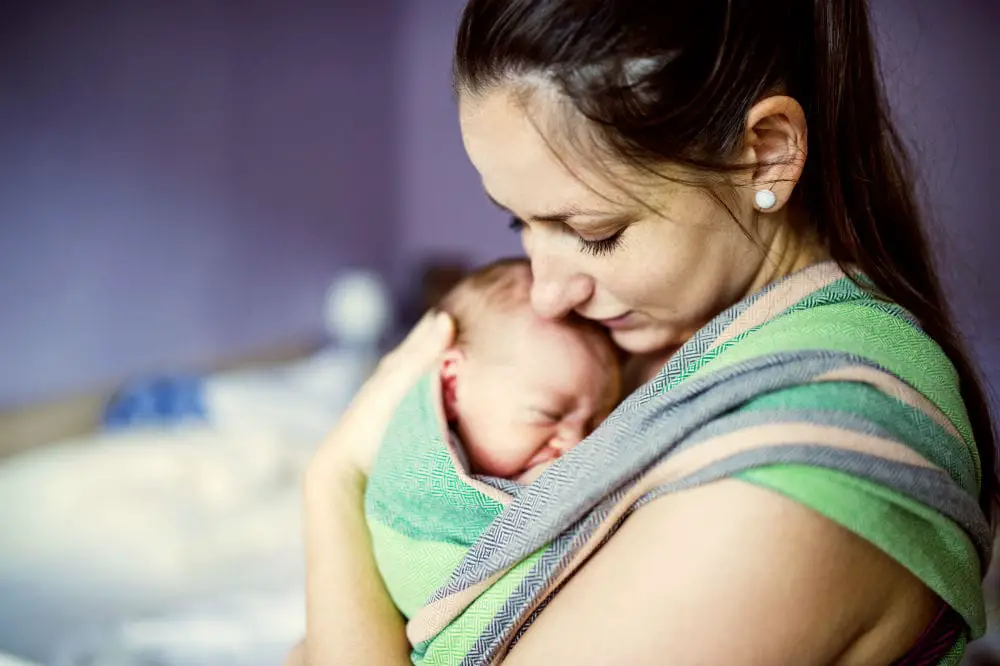Vikle-mor? Sådan bærer du dit barn
En vikle er mere eller mindre et stort stykke stof, som du binder om dig selv og baby, så baby sidder på din ryg, hofte eller din mave. Når du vikler dit barn rigtigt, sidder det ergonomisk korrekt, og du kan bruge viklen fra dag 1, og indtil dit barn ikke vil bæres mere.
Vil du gerne i gang med at vikle, men er i tvivl om det er for kompliceret?
Eller overvejer du, om en vikle i det hele taget er pengene værd?
Så læs med her, hvor vi kommer ind på hvad der er godt at vide, inden du investerer i din egen vikle.

Fastvikle vs. strækvikle
Når du skal vælge hvilken vikle du gerne vil have, så kan du vælge mellem enten en strækvikle eller en fastvikle. Her gennemgår vi meget kort, hvad de to forskellige vikler kan.
Strækviklen
En strækvikle er en meget blød vikle, der kan strække sig i stoffet. Den er nem at binde, og du kan sagtens binde den rigtigt som nybegynder. Den er heller ikke dyr i anskaffelse. Til gengæld kan den kun bruges de første 3-4 mdr., da baby herefter er blevet for tung. Til gengæld er det ikke sikkert, at du overhovedet har behov for at bære din baby herefter.
Det skal du vide om en strækvikle
- Strækviklen er billig og nem at binde
- Perfekt til nyfødte
- Den kan kun bruges de første 3-4 mdr., hvor behovet for at bære nok også er størst
Fastviklen
En fastvikle er dyrere, men kan til gengæld bruges i alt den tid du bærer. Det lækre ved fastvikler er også, at de fås i alverdens farver og mønstre, så du virkelig kan vælge en der falder i din og din babys smag.
Derudover kan du vælge mellem forskellige materialer – eller “blends” som det kaldes. Det billigste er nok 100% bomuld, men du kan også få blends med silke, uld, bambus og andet.
Fastviklen kan bindes på rigtig mange forskellige måder. Du kan bære dit barn foran, på siden og på hoften. Som navnet antyder, så er viklen “fast” – dvs. den kan ikke strække sig i stoffet, sådan som en strækvikle kan.
Fastviklen fås i forskellige størrelser. Hvis du kun skal bruge den til rygbindinger, så kan du nøjes med en kortere vikle, for eksempel størrelse 4. De mest normale størrelser er størrelse 5 eller 6. Hvilken størrelse der er bedst til dig, kommer an på din kropsform.
Du kan finde masser af eksempler på fastvikle bindinger på youtube eller du kan søge råd hos den kæmpe gruppe på Facebook, der hedder “Slyngegalleriet”.
Det skal du vide om fastviklen
- Fastvikler er generelt dyrere i anskaffelse end strækvikler
- De kan bruges fra dag 1, og indtil dit barn ikke vil bæres mere (typisk 2-3 års alderen)
- Vælg mellem et utal af smukke farver, mønstre og blends
Fordele ved at bære dit barn i en vikle
Der er utrolig mange fordele ved at bære dig barn, så længe både du og dit barn trives med det. De helt små vil ofte falde til ro, når de er helt tætte med deres mor eller far, sådan som de har været vant til at have det inde i mors mave. Når de sidder i viklen, kan de høre hjerteslag, og få den vigtige hud-mod-hud kontakt, der i øvrigt også fremmer mælkeproduktionen.
Derudover har du hænderne fri til at smøre dig en mad, tage dig af en eventuelt storebror / storesøster, og det er faktisk bare rigtig hyggeligt at have den lille helt tæt på.
- Baby får hud-mod-hud kontakt
- Du har hænderne fri
- Det er hyggeligt
- Dit barn vugges naturligt, og vil ofte falde til ro og sove i viklen
Ulemper, når du skal bære dit barn
Som med alt andet, medfører det også ulemper og udfordringer når du er vikle-mor. Hvis du vælger viklen frem for bæreselen, er det ikke altid lige nemt at få bundet baby op, så han eller hun sidder korrekt. Hvis din baby virkelig elsker at sidde i viklen, vil den lille måske sidde der hele tiden for at falde til ro, og det kan godt gå hen og blive tungt for ryggen. For nogen kan det også være hårdt, at man i de første måneder af babys liv aldrig kan være alene.
Endnu en udfordring er, når det bliver koldt udenfor. I en barnevogn er det noget nemmere at putte baby med dyne eller i en sovepose, men hvis du vikler må du tænke kreativt. Det kan meget vel blive nødvendigt at investere i benvarmere til baby, en varm uld-vikle eller måske endda en bærejakke, så den lille ikke bliver kold.
Når du er på farten er det både nemt at have baby med i viklen, men svært at bære på pusletasken også. Dette kan løses med en rygsæk, men så er der også læs på.
- Din baby vil måske kun sove i viklen
- Det kan kræve nyt udstyr og overtøj, når baby skal holdes varm i viklen om vinteren
- Besværligt at bære rundt på både barn, pusletaske og dine egne småting, når du er på farten
- Du kan få ondt i ryggen af at bære dit barn hele tiden
De nævnte fordele og ulemper er nok grunden til, at langt de fleste vælger både at bruge vikle og en almindelig barnevogn. Så kan du bruge det, der giver mest mening i situationen. Det ene udelukker heldigvis ikke det andet.
Er en bæresele noget for dig?
Hvis du slet ikke er til vikler, så kan du også sagtens bruge en god ergonomisk bæresele. En bæresele skal ikke bindes som en vikle, men klikkes fast med spænder og remme.

De seneste år har der været meget fokus på ergonomien i bæreseler. I tidligere modeller har barnet siddet forkert, sådan at hele deres vægt var på skridtet, og benene hang løst ned, hvilket ikke er en ergonomisk korrekt stilling og bæreselen derfor helst kun skulle bruges i 20 minutter ad gangen. Det gælder blandt andet den gamle model af “Baby Björn” bæresele.
Men der findes også mange gode ergonomiske bæreseler, hvor barnet sidder godt, og kan sidde der uden tidsbegrænsning. Blandt ergonomiske bæreseler kan nævnes Ergobaby, Manduca og Tula. Se meget mere om disse her.

